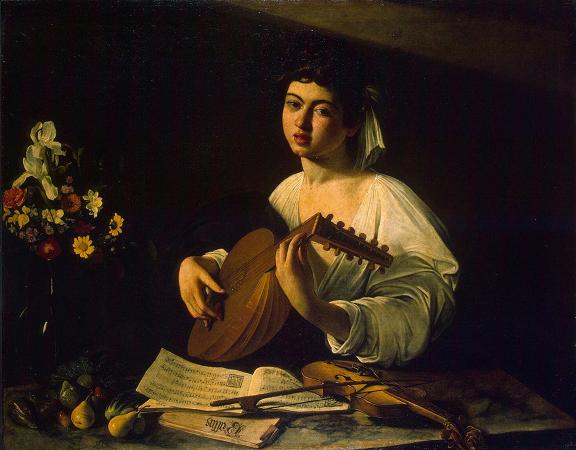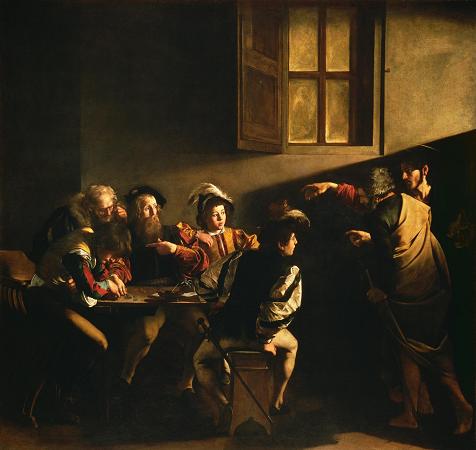Lute Player (c1597). Oil on canvas. 94 x 119. The Lute Player is a composition by the Italian Baroque master Caravaggio. It used to exist in two versions, one in the Wildenstein Collection and another in the Hermitage Museum, St. Petersburg. However, a third from Badminton House, Gloucestershire, came to light in 2007. Caravaggio's early biographer Giovanni Baglione gives the following description of a piece done by the artist for his patron Cardinal Francesco Del Monte: E dipinse anche un giovane, che sonava il Lauto, che vivo, e vero il tutto parea con una caraffa di fiori piena d'acqua, che dentro il reflesso d'ua fenestra eccelentemente si scorgeva con altri ripercotimenti di quella camera dentro l'acqua, e sopra quei fiori eravi una viva rugiada con ogni esquisita diligenza finta. E questo che fu il piu bel pezzo, che facesse mai. The painting exists in three versions. All show a boy with soft facial features and thick brown hair, accompanying himself on the lute as he sings a madrigal about love. As in the Uffizi Bacchus, the artist places a table-top in front of the figure. In the Hermitage and Badminton House versions it is bare marble, with a violin on one side and a still life of flowers and fruit on the other. In the Wildenstein version the table is covered with a carpet and extended forwards to hold a tenor recorder, while the still life is replaced by a spinetta and a caged songbird. The musical instruments are valuable and probably came from Del Monte's personal collection. The Hermitage and Badminton House versions show madrigals by Jacques Arcadelt, and the visible text reads in part: Vous savez que je vous aime et vous adore. Je fus votre. The Wildenstein version shows songs by a native Florentine on a text by Petrarch: Laisse le voile and Pourquoi ne vous donnez-vous pas? by Giachetto Berchem. The flowers and damaged fruit, and the cracked body of the lute, suggest the theme of transience: love, like all things, is fleeting and mortal. The choice of Franco-Flemish composers over native Italians-only Layolle was a native Italian-no doubt reflects the cultural affiliations of the pro-French Del Monte-Giustiniani circle. The still life elements are of an extremely high standard in all versions, the finely rendered fruit and flowers in two versions equalled by the textures of spinetta and flute in the other, and the artist has reproduced the initial notes of the madrigals so exactly that one can recognize the Roman printer, Valerio Dorica. The rather androgynous model could be Pedro Montoya, a castrato known to have been a member of the Del Monte household and a singer at the Sistine Chapel at about this time-castrati were highly prized and the Cardinal was a patron of music as well as of painting. More recently Caravaggio biographer Peter Robb has identified him as Caravaggio's companion Mario Minniti, the model for several other paintings from this period including The Cardsharps and one of the two versions of The Fortune Teller. All three versions demonstrate the innovative approach to light that Caravaggio adopted at this time. Caravaggio's method, as described by Caravaggio's contemporary Giulio Mancini, was to use a strong light from above with a single window and the walls painted black, so that having the lights bright and the shadows dark, it gives depth to the painting, but with a method that is not natural nor done or thought of by any other century or older painters like Raphael, Titian, Correggio and others. The room itself seems to be the same as that in the Contarelli Chapel Calling of Saint Matthew, and the beam of light across the rear wall has an upper limit that would appear to be the shutter of the window above the table in the Calling. The carafe is a cut-and-paste motif from another image, where the main light came from a window at more or less the same level as the carafe itself. Such a complex illustration of refracted light is unprecedented in the Cinquecento, and may have been the result of collaboration with scientists in Del Monte's circle, including Giovanni Battista della Porta, who was the guiding spirit behind the foundation in 1603 of the Accademia dei Lincei. His multi-volume De Refractione Optices was particularly concerned with optical matters, the second volume being devoted entirely to the incidence of light on water-filled and glass spheres. The circle of Della Porta was significant for Caravaggio later on in Naples, where the commission for the Seven Acts of Mercy seems to have emanated from Giovanni Batista Manso, Marchese di Villa, whose friend, the alchemist Colantonio Stigliola, was a member of the Accademia dei Lincei.
more...




